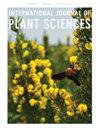Contrasting Patterns of Genome Size Diversity in Island Endemic Artemisia (Asteraceae)
IF 1.5
3区 生物学
Q3 PLANT SCIENCES
引用次数: 0
Abstract
Premise of research. Genome size has cascading effects at nuclear, cell, and whole-organism levels, with consequences in the biology of the species. Large genomes impose higher metabolic and energetic costs, which might be exceedingly limiting for species to thrive under stressing environments, such as island archipelagos. Methodology. We mined online databases to collate available data on chromosome numbers and genome sizes in the genus Artemisia, which colonized Macaronesia and Hawaii archipelagos. We applied phylogenetic-based modeling approaches to reconstruct the evolution of these two traits to estimate ancestral states as well as the main mechanisms of change. Pivotal results. On the basis of extant chromosome data, our analyses discard polyploidy as a likely mechanism for speciation in Macaronesia or Hawaii. However, contrasting genome size patterns are found. Hawaiian endemics account for the smallest genomes in Artemisia, while those of Macaronesian endemics fall well above the average size in the genus. Conclusions. The evidence gathered in Artemisia indicates that, rather than genome downsizing, the presence of small genomes most likely predated colonization of Hawaii, which could have been key for a long dispersal from an Asian ancestor. Such a pattern does not hold in Macaronesia, which is relatively closer to mainland compared with Hawaii, hence suggesting that geographical isolation might reduce the likelihood of a large-genomed taxon to successfully colonize remote island archipelagos.海岛特有蒿(菊科)基因组大小多样性对比
研究的前提。基因组大小在核、细胞和整个生物体水平上具有级联效应,对物种的生物学产生影响。大基因组带来了更高的代谢和能量成本,这可能极大地限制了物种在压力环境下的繁殖,比如岛屿群岛。方法。我们挖掘了在线数据库,整理了在马卡罗尼西亚和夏威夷群岛上定居的青蒿属的染色体数量和基因组大小的可用数据。我们应用基于系统发育的建模方法来重建这两个性状的进化,以估计祖先状态以及变化的主要机制。关键的结果。在现有染色体数据的基础上,我们的分析放弃了多倍体作为马卡罗尼西亚或夏威夷物种形成的可能机制。然而,对比基因组大小模式被发现。夏威夷特有的基因组在青蒿属中是最小的,而马卡罗尼西亚特有的基因组则远高于该属的平均大小。结论。在青蒿岛收集到的证据表明,小基因组的存在很可能早于夏威夷的殖民化,而不是基因组缩小,这可能是亚洲祖先长期扩散的关键。这种模式在马卡罗尼西亚并不适用,与夏威夷相比,马卡罗尼西亚离大陆相对更近,因此表明地理隔离可能会降低大基因组分类单元成功殖民偏远岛屿群岛的可能性。
本文章由计算机程序翻译,如有差异,请以英文原文为准。
求助全文
约1分钟内获得全文
求助全文
来源期刊
CiteScore
4.50
自引率
4.30%
发文量
65
审稿时长
6-12 weeks
期刊介绍:
The International Journal of Plant Sciences has a distinguished history of publishing research in the plant sciences since 1875. IJPS presents high quality, original, peer-reviewed research from laboratories around the world in all areas of the plant sciences. Topics covered range from genetics and genomics, developmental and cell biology, biochemistry and physiology, to morphology and anatomy, systematics, evolution, paleobotany, plant-microbe interactions, and ecology. IJPS does NOT publish papers on agriculture or crop improvement. In addition to full-length research papers, IJPS publishes review articles, including the open access Coulter Reviews, rapid communications, and perspectives. IJPS welcomes contributions that present evaluations and new perspectives on areas of current interest in plant biology. IJPS publishes nine issues per year and regularly features special issues on topics of particular interest, including new and exciting research originally presented at major botanical conferences.

 求助内容:
求助内容: 应助结果提醒方式:
应助结果提醒方式:


